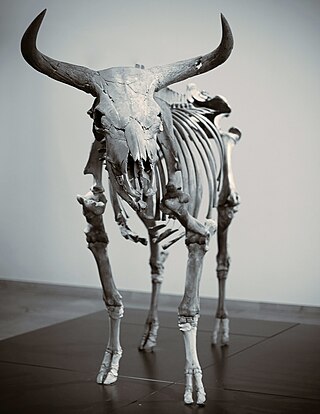
The aurochs is an extinct cattle species, considered to be the wild ancestor of modern domestic cattle. With a shoulder height of up to 180 cm (71 in) in bulls and 155 cm (61 in) in cows, it was one of the largest herbivores in the Holocene; it had massive elongated and broad horns that reached 80 cm (31 in) in length.
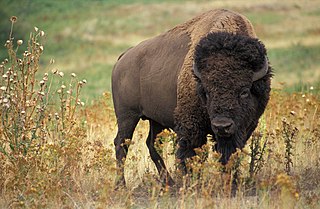
A bison is a large bovine in the genus Bison within the tribe Bovini. Two extant and numerous extinct species are recognised.

The American bison, also called the American buffalo or simply buffalo, is a species of bison native to North America. It is one of two extant species of bison, alongside the European bison. Its historical range, by 9000 BCE, is described as the great bison belt, a tract of rich grassland that ran from Alaska to the Gulf of Mexico, east to the Atlantic Seaboard, as far north as New York, south to Georgia, and according to some sources, further south to Florida, with sightings in North Carolina near Buffalo Ford on the Catawba River as late as 1750.
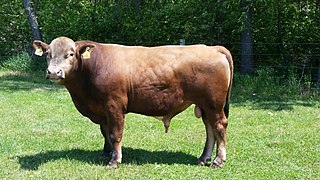
Beefalo constitute a hybrid offspring of domestic cattle, usually a male in managed breeding programs, and the American bison, usually a female in managed breeding programs. The breed was created to combine the characteristics of both animals for beef production.

The zebu, sometimes known in the plural as indicine cattle, Camel cow or humped cattle, is a species or subspecies of domestic cattle originating in South Asia. Zebu, like many Sanga cattle breeds, differs from taurine cattle by a fatty hump on their shoulders, a large dewlap, and sometimes drooping ears. They are well adapted to withstanding high temperatures and are farmed throughout the tropics.

Bos is a genus of wild and domestic cattle.
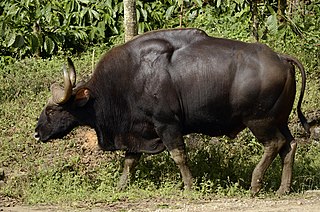
The gaur, also known as the Indian bison, is a bovine native to South Asia and Southeast Asia, and has been listed as Vulnerable on the IUCN Red List since 1986. The global population was estimated at a maximum of 21,000 mature individuals in 2016, with the majority of those existing in India.
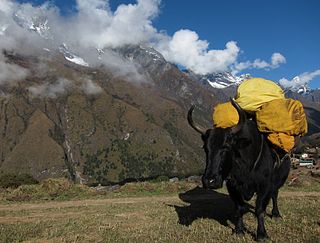
A dzo is a hybrid between the yak and domestic cattle. The word dzo technically refers to a male hybrid, while a female is known as a dzomo or zhom. In Mongolian, it is called a khainag (хайнаг). There is also the English language portmanteau term of yattle, a combination of the words yak and cattle, as well as yakow, a combination of the words yak and cow.

The yak, also known as the Tartary ox, grunting ox, or hairy cattle, is a species of long-haired domesticated cattle found throughout the Himalayan region of South Asia, the Tibetan Plateau, Gilgit-Baltistan (Kashmir), Tajikistan and as far north as Mongolia and Siberia. It is descended from the wild yak.
A crossbreed is an organism with purebred parents of two different breeds, varieties, or populations. Crossbreeding, sometimes called "designer crossbreeding", is the process of breeding such an organism. While crossbreeding is used to maintain health and viability of organisms, irresponsible crossbreeding can also produce organisms of inferior quality or dilute a purebred gene pool to the point of extinction of a given breed of organism.

A bovid hybrid is the hybrid offspring of members of two different species of the bovid family. There are 143 extant species of bovid, and the widespread domestication of several species has led to an interest in hybridisation for the purpose of encouraging traits useful to humans, and to preserve declining populations. Bovid hybrids may occur naturally through undirected interbreeding, traditional pastoral practices, or may be the result of modern interventions, sometimes bringing together species from different parts of the world.

The tribe Bovini or wild cattle are medium to massive bovines that are native to Eurasia, North America, and Africa. These include the enigmatic, antelope-like saola, the African and Asiatic buffalos, and a clade that consists of bison and the wild cattle of the genus Bos. Not only are they the largest members of the subfamily Bovinae, they are the largest species of their family Bovidae. The largest species is the gaur, weighing up to 1,500 kg (3,300 lb).

Cattle are large, domesticated, bovid ungulates widely kept as livestock. They are prominent modern members of the subfamily Bovinae and the most widespread species of the genus Bos. Mature female cattle are called cows and mature male cattle are bulls. Young female cattle (heifers), young male cattle, and castrated male cattle (steers) are all colloquially called "cows".
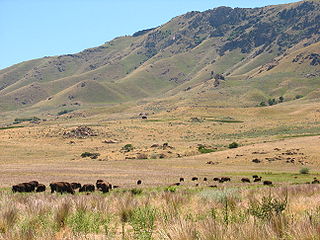
The Antelope Island bison herd is a semi–free-ranging population of American bison in Antelope Island State Park in Great Salt Lake, Utah. Bison were introduced to Antelope Island in 1893. The herd is significant because it is one of the largest and oldest publicly owned bison herds in the nation. The Antelope Island bison herd currently numbers between 550 and 700 individuals. Though the bison on Antelope Island are Prairie bison, which was the most common bison subspecies in North America, the bison have a distinct genetic heritage from many of the other bison herds in the United States and they are considered to be desirable as part of the breeding and foundation stock for other bison herds, because of their separate genetic heritage and some of the distinct genetic markers that are found in the population.
The Henry Mountains bison herd, numbering 250 to 400 American bison, is one of only four free-roaming bison herds on public lands in North America. The other three herds are the Yellowstone bison herd which was the ancestral herd for the Henry Mountains animals, the Wind Cave bison herd in South Dakota and the herd on Elk Island in Alberta, Canada.

The Wind Cave bison herd is a herd of 250–400 American bison in Wind Cave National Park, South Dakota, United States. As an active participant in the conservation of American bison, it is believed to be one of only seven free-roaming and genetically pure herds on public lands in North America. The other six herds are in Yellowstone Park, Theodore Roosevelt National Park, Henry Mountains, Blue Mounds State Park (Minnesota), Minneopa State Park (Minnesota), and Elk Island National Park. The Wind Cave herd are of the Plains bison subspecies.
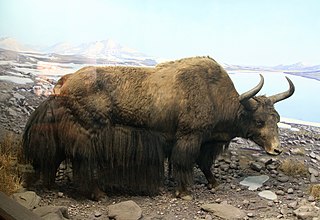
The wild yak is a large, wild bovine native to the Himalayas. It is the ancestor of the domestic yak.
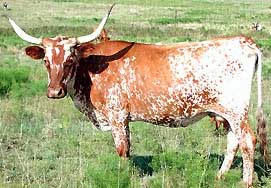
Bovina is a subtribe of the Bovini tribe that generally includes the two living genera, Bison and Bos. However, this dichotomy has been challenged recently by molecular work that suggests that Bison should be regarded as a subgenus of Bos. Wild bovinans can be found naturally in North America and Eurasia.














